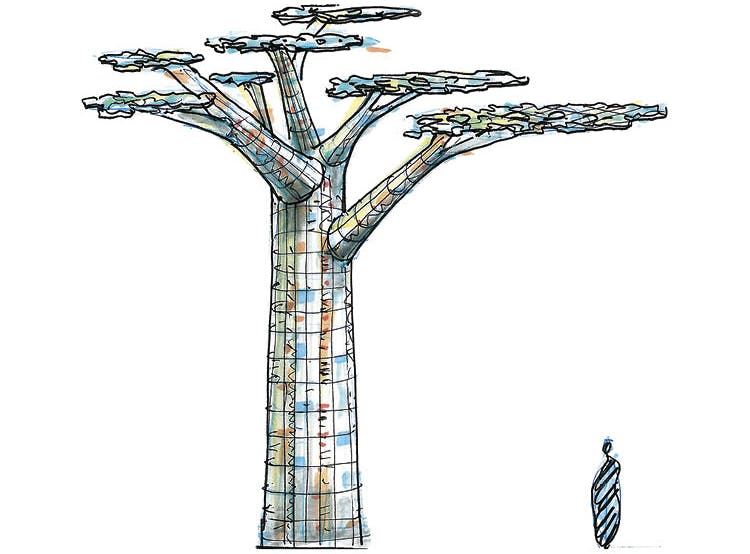
- Magazine Article
- Exhibitions
Ámà: The Gathering Place
A welcoming installation in the atrium evokes a West African village square

Ámà: The Gathering Place, a new site-specific commission by Emeka Ogboh (Nigerian, b. 1977), will enliven the Cleveland Museum of Art’s Ames Family Atrium this summer and fall. This is the CMA’s first commissioned artwork for the atrium and part of an ongoing series of large-scale contemporary art installations that will periodically be presented in that setting.
When Ogboh first entered the atrium while preparing for this project, he was surprised, even daunted, by the scale of the soaring space. Instinctively, he turned his attention away from the atrium’s monumental architecture to the bustle of people and the activities that unfold within its physical frame. One of Cleveland’s largest freely accessible indoor spaces, the atrium is used by locals and out-of-towners alike as a place for gathering, dining, working, and relaxing. Ogboh spent hours making sketches and speaking with people about how they experienced the space, learning in the process that the atrium is “warm and welcoming,” “a social space,” “a place for reflection,” and “the heart and soul of the
museum.”
Ogboh compares the social role of the atrium to that of the ámà, or village square, the central force of Igbo life in his native southeast Nigeria. “Both sites,” he says, “are contact zones, spaces of gathering and of ritual activities, in their respective settings.” Based on this analogy, Ogboh determined the installation’s key components—choral music, a sculptural rendering of a tree, and textiles—all of which are rooted in a traditional Igbo context but are reimagined through a contemporary global lens. Just as memories are not so much accurate records of the past as they are impressions reconfigured by subsequent experience, Ogboh’s installation does not faithfully re-create an Igbo village square in Cleveland. Instead, it evokes some of the ámà’s defining elements to serve as a framework for engaging with an altogether different setting on the other side of the world.

This new work continues Ogboh’s multisensory approach to interpreting place, which is at the core of his art. Through previous audio installations he has explored how sound impacts our experience of the world around us and has used his work to address topical issues of immigration, globalization, and postcolonialism. These works have been featured in numerous solo exhibitions, public art commissions, and significant international surveys, including Documenta 14 (2017), Skulptur Projekte Münster (2017), the 56th edition of the Venice Biennale (2015), and the Dakar Biennale (2014).
For Ámà: The Gathering Place, newly commissioned recordings of Igbo folk songs, performed by a 12-person choir, will fill the atrium. This core facet of the work is grounded in the tradition of choral music typically performed in the Igbo ámà for entertainment and during ritual ceremonies. In this installation, the music is transmitted through multichannel speakers, which Ogboh has designed to create three discrete zones of sound. The music travels unpredictably between the zones, and for a continuous listening experience visitors must physically follow the music. By using the Igbo soundscape to influence specific paths of movement, Ogboh sets up a structure for the work in which the foreign and the local are mutually dependent.
During his second visit to Cleveland, Ogboh determined that the installation needed a powerful visual anchor around which sound and its related paths of movement would revolve. Thus emerged the idea for a looming sculptural representation of a tree in zone three. The 25-foot steel and aluminum construction was inspired by the central presence of a tree in the Igbo ámà, marking the site as a meeting place and inviting pause in its shade. The tree places Ámà: The Gathering Place in a distinctive setting elsewhere, even as the installation responds to its specific surroundings.
The third marker of this work’s Igbo folk origins is the regionally specific Akwete cloth that was produced for this project bearing both traditional design patterns and contemporary motifs. One of West Africa’s oldest and most celebrated textile traditions, Akwete has bold colors and striking patterns and adorns bodies on ceremonial and festive occasions at the ámà. Maintaining its functional role, the Akwete in Ogboh’s project stands in as bark on the surface of the tree and covers beanbag chairs for visitors to recline and listen. The patterns on display were created by Nigerian graphic designers, who combine traditional patterns and contemporary designs.
Mirroring the global scope of the CMA’s collection, Ámà: The Gathering Place offers an immersive welcome to visitors, serving as a prologue through which to enter the museum’s encyclopedic galleries, which display culture spanning the farthest reaches of the world.
Cleveland Art, July/August 2019